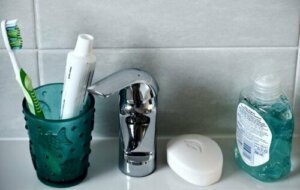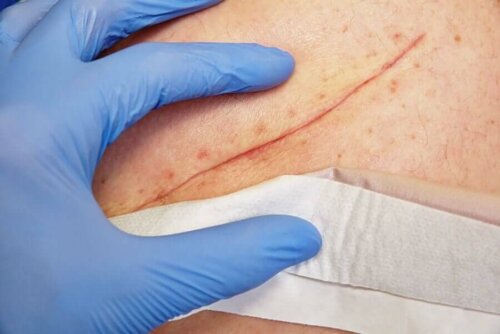Chlorhexidine - A Multipurpose Antiseptic


Reviewed and approved by the dentist Vanesa Evangelina Buffa
Chlorhexidine is an antiseptic that prevents the growth of bacteria, the main producers of infection. What it does is prevent the growth of bacteria on body tissues.
The difference between a disinfectant and an antiseptic lies in the surface or material each of them is effective on. The first inhibits bacterial growth in inert materials, while an antiseptic acts on living body tissues such as the skin.
The objectives of using chlorhexidine in the oral mucous membranes are to eliminate and prevent bacterial growth. Thus, it reduces the risk of an infected wound without being too harsh on the area where you apply it.
This compound sticks to the oral mucosa and releases gradually over eight hours, approximately. For this reason, professionals recommend chlorhexidine rinses two to three times a day.
Chlorhexidine indications
This antiseptic is routinely used in dentistry, especially in the treatment of minor injuries to the oral mucosa. Chlorhexidine treatments can either be general or localized, depending on the suitability of the area to treat.
General treatment
You’ve probably used chlorhexidine if you have a chronic tendency to suffer from canker sores or any other type of similar discomfort. Professionals recommend using chlorhexidine as a rinse, after brushing. In addition, this component is also present in some kinds of toothpaste.
Localized injuries
You can use it as a spray if you need to treat localized injuries. This is because the action of this format is more localized and punctual. In fact, the localized application of this antiseptic is indicated in the following instances:
- Mouth infections
- Tongue wounds
- After a surgical intervention

You may also be interested in Five Natural Ingredients to Get Rid of Boils
The specific oral use of chlorhexidine
Chlorhexidine for oral treatments is usually used diluted in concentrations of 0.2%, 0, 12% and 0.10%. One can apply it through different formats such as gels, sprays, and toothpaste. You must use the chlorhexidine mouthwash 30 minutes after brushing, rinsing a little bit of it for 30 seconds.
To treat localized injuries, such as dental surgery, professionals usually recommend the spray. This is because it has two important advantages:
- The action is more localized
- Also, the antiseptic effect is greater
You shouldn’t use this antiseptic for long periods of time because it could stain your teeth as well as darken your gums. However, don’t worry if it happens to you as these effects will disappear after you discontinue its use.
Recommended use
Most people who use chlorhexidine do so right after brushing as if it were a frequently used mouthwash. However, this isn’t right. In fact, the best time to use it is at least half an hour after brushing your teeth.
The reason why this is recommended is that chlorhexidine isn’t compatible with some of the components of many kinds of toothpaste. Some of these include sodium lauryl sulfate and sodium mono-fluorophosphate.
Its use as a topical antiseptic
Another use for Chlorhexidine is as a topical antiseptic. This is because it’s effective against a wide spectrum of microorganisms. It offers many advantages such as not being abrasive or irritating. In addition, it doesn’t interact with blood. Furthermore, this compound is hardly toxic and you can use it on open wounds such as chafing, cuts, and burns.

Also read: The Multiple Uses of the Mineral Alum
Side effects of chlorhexidine
The use of this compound doesn’t entail significant side effects, although some allergy symptoms and rashes may appear in the area of application in a small percentage of its users.
As we mentioned above, the long-term use of chlorhexidine as an oral treatment can cause stains on the teeth and potentiate those produced by coffee or tobacco.
Chlorhexidine is essential
Chlorhexidine is an antiseptic that’s particularly effective against bacteria and fungi. Its use is widespread worldwide, so much so that it made the World Health Organization Model List of Essential Medicines.
All cited sources were thoroughly reviewed by our team to ensure their quality, reliability, currency, and validity. The bibliography of this article was considered reliable and of academic or scientific accuracy.
- Chicharro Luna, E., Pertegal Vázquez, F., Pérez Prieto, M., Baño Ruíz, L., & Pérez Saura, I. (2008). Clorhexidina vs povidona iodada como antiséptico de la piel. Revista Española de Podología.
- Torres, M., Díaz, M., & Acosta, A. (2009). La clorhexidina, bases estructurales y aplicaciones en la estomatologia. Gac Med Espiritual.
- Bascones, A., & Morante, S. (2006). Antisépticos orales: Revisión de la literatura y perspectiva actual. Avances en periodoncia e implantología oral, 18(1), 21-29.
- Beraún, A. P. (2011). Acción antimicrobiana del digluconato de clorhexidina al 0.12% en Estreptococcus del grupo mutans después del uso de una pasta dental que contiene Lauril Sulfato de Sodio. Revista Científica Visión Dental, 14(2-3), 770-776.
- Ayala, G., Álvarez, M., & Nuñez, M. (2016). Efecto de la combinación de clorhexidina y fluoruro de sodio sobre Streptococcus mutans en preescolares con manchas blancas. Revista Estomatológica Herediana. https://doi.org/10.20453/reh.v26i3.2956
- Morante Mudarra, S. (2018). Valoración cruzada ya doble ciego, mediante el modelo de gingivitis experimental, de la eficacia de tres colutorios de clorhexidina sin alcohol frente a la prevención de gingivitis ya la neoformación de placa supragingival. Ene, 9, 15.
- Urquet, A. O., & Spada, V. A. (2022). Clorhexidina y la Odontología. In V Jornadas de Actualización en Prácticas Odontológicas Integradas PPS-SEPOI (La Plata, 3 de noviembre de 2022).
- Bustamante, O. C., Troncos, L. G. P., de Zebrauskas, A. P. P., Leandro, K. C. R., & Sime, C. L. D. C. H. (2020). Antisépticos Orales: Clorhexidina, flúor y triclosán. Salud & Vida Sipanense, 7(1), 4-16.
This text is provided for informational purposes only and does not replace consultation with a professional. If in doubt, consult your specialist.








